Separate site selection for construction project land
Separate site selection for construction project land
Approval process
According to the Land Management Law, the land for general construction projects should be arranged within the scope of urban, village, and town construction land determined by national spatial planning. Only construction projects such as energy, transportation, water conservancy, mining, military facilities, etc. can apply for land within and outside the construction land scope of cities, villages, and towns determined by national spatial planning according to the characteristics of the construction project, and apply for separate site selection for construction projects. This article is about the regulations on the approval process for land use for separately selected construction projects. According to this provision, the construction project land shall be selected separately and the construction approval procedures shall be handled according to the following process.
Preliminary Land Use Review and Site Selection Opinion
According to the Decision of the State Council on the Reform of the Investment System, the review of construction projects is divided into three methods: approval and filing: construction projects using fiscal funds are subject to an approval system; Enterprises that do not use fiscal funds for investment and construction projects are classified according to different situations. Large scale or restricted projects are subject to approval system, while others are subject to filing system. Construction projects that are subject to approval and pre-approval shall submit a pre-approval application for construction land before approval and pre-approval, while construction projects that are subject to filing shall submit a pre-approval application for construction land after filing. The natural resources authority shall review the land use matters of construction projects and provide preliminary review opinions on the land use of construction projects. According to the Land Management Law, the preliminary review of construction land mainly examines whether the site selection of construction projects complies with the national spatial planning and annual land use plan, as well as whether it meets the standards for construction land. At the same time, according to the Urban and Rural Planning Law, if a construction project that requires approval or approval from relevant departments in accordance with national regulations provides state-owned land use rights through allocation, the construction unit shall apply to the competent department of urban and rural planning for the issuance of a site selection opinion letter before submitting it for approval or approval to the relevant department.
Approval for Conversion of Agricultural Land
Construction projects that are subject to approval and pre-approval shall submit a pre-approval application for construction land before approval and pre-approval, while construction projects that are subject to filing shall submit a pre-approval application for construction land after filing. The natural resources authority shall review the land use matters of construction projects and provide preliminary review opinions on the land use of construction projects. According to the Land Management Law, the preliminary review of construction land mainly examines whether the site selection of construction projects complies with the national spatial planning and annual land use plan, as well as whether it meets the standards for construction land. At the same time, according to the Urban and Rural Planning Law, if a construction project that requires approval or approval from relevant departments in accordance with national regulations provides state-owned land use rights through allocation, the construction unit shall apply to the competent department of urban and rural planning for the issuance of a site selection opinion letter before submitting it for approval or approval to the relevant department. For those who occupy permanent basic farmland, the State Council shall approve the conversion of agricultural land; Those that do not occupy permanent basic farmland shall be approved by the people's governments of provinces, autonomous regions, and municipalities directly under the Central Government authorized by the State Council. According to Article 44, Paragraph 3 of the Land Management Law, for cities approved by the State Council for overall land use planning, if agricultural land other than permanent basic farmland is converted into construction land in batches according to the annual land use plan within the scope of construction land, it shall be approved by the State Council; According to Article 44, Paragraph 4 of the Land Management Law, the conversion of agricultural land other than permanent basic farmland to construction land outside the scope of construction land scale determined in the overall land use planning for cities, villages, and towns shall be approved by the State Council. The State Council has authorized the people's governments of provinces, autonomous regions, and municipalities directly under the Central Government to approve the conversion of agricultural land that does not occupy permanent basic farmland. Those that should be submitted to the State Council for approval according to law must be reviewed by the people's governments of provinces, autonomous regions, and municipalities directly under the Central Government before they can be submitted to the State Council for approval. The approval for the conversion of agricultural land shall be formulated by the natural resources and other departments organized by the municipal and county people's governments. The plan for the conversion of agricultural land should clearly state the key points of the plan, including whether the construction project land complies with the national spatial planning and annual land use plan, as well as the situation of supplementary arable land. For those involving the occupation of permanent basic farmland, a demonstration report on the occupation of permanent basic farmland should also be submitted, with a focus on explaining the necessity, rationality, and possibility of supplementary planning for the occupation of permanent basic farmland. At present, six major construction projects are allowed to occupy permanent basic farmland with legal approval. One is major construction projects explicitly supported by the Party Central Committee and the State Council (including projects with specific names specified in documents or approved plans issued by the Party Central Committee and the State Council, as well as projects approved by the State Council). The second category is military defense. Military defense projects approved by the Central Committee of the Military Commission and its relevant departments. The third category is transportation, including airport projects, railway projects, and highway projects. In addition, to address the prominent issues currently present in the local area, some highway projects planned for the provincial highway network will be included in the scope of acceptance, including provincial highways and provincial highways that directly serve deeply impoverished areas. The fourth category is energy, including energy projects and other energy projects that are clearly planned at the national level, as well as energy extraction, oil and gas pipelines, hydropower, and nuclear power projects that are clearly planned at the national level and comply with national industrial policies. The fifth category is water conservancy projects, which are clearly planned at the national level. Sixth, in order to implement the major decisions and deployments of the Party Central Committee and the State Council, the investment department of the State Council or the investment department of the State Council, together with relevant departments, supports and recognizes transportation, energy, and water conservancy infrastructure projects. ###Implementation of agricultural land conversion plan After the plan for converting agricultural land is approved in accordance with the law, it shall be organized and implemented by the municipal and county people's governments. The most important aspect of implementing the plan for the conversion of agricultural land is to effectively implement the requirement of balancing the occupation and compensation of arable land, and to ensure that the compensation for arable land occupied by construction is sufficient, and that the quantity and quality of the compensated arable land are equivalent to those occupied by construction. The construction project with separate site selection, which has been legally approved to occupy arable land, shall fulfill the legal obligation of compensating arable land by the construction unit. If the construction unit cannot supplement arable land or the supplemented arable land does not meet the requirements, it shall pay the arable land reclamation fee, and the local people's government that collects the arable land reclamation fee shall fulfill the obligation of supplementing arable land on its behalf. Local governments at all levels are responsible for organizing and implementing land consolidation, promoting the construction of high standard farmland through land consolidation, reclamation, and development, increasing the quantity and improving the quality of arable land, with county-level self balancing as the main approach, provincial adjustment as a supplement, and moderate national coordination as a supplement, to implement the task of supplementing arable land.
Typical case
Transportation industry
Hebei section of Beijing Xiong'an New Area Expressway
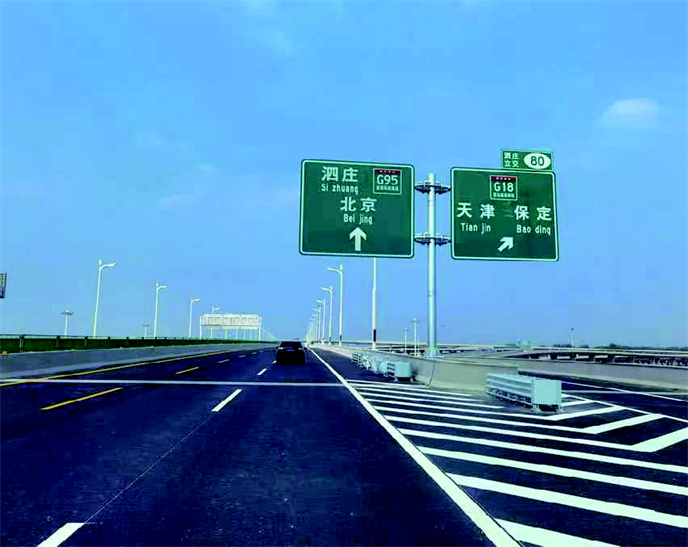
The total length of the Hebei section of Beijing-Xiongan expressway is 75 kilometers, with a total investment of 21.828 billion yuan. The main line starts from the boundary between Beijing and Hebei in Zhuozhou City, passes through Zhuozhou City, Gu'an County, Gaobeidian City, and Baigou New City in the south, and directly reaches Xiong'an New Area, connecting with the existing Rongwu Expressway; The eastern section of the branch line starts from Daxing, Beijing The Yongding River between Shifa Village in the district and Nancai Village in Yihezhuang Township, Zhuozhou City, Hebei Province, runs northwest through Nancai Village to the north of Yihezhuang Township, with a total length of 5.615 kilometers; The Zhuozhou East Interchange Connection Line starts from the south of Yihezhuang Township in Zhuozhou City, passes through the north of Nanren Village to the west, crosses the Baigou River, and ends at the intersection of the North Ring Road and Jingbai Highway in Zhuozhou City, with a total length of 7.299 kilometers; The Gaobeidian Connection Line starts from the south of Huangxinzhuang Village in Gaobeidian City, connects with the Jingbai Highway, runs eastward through Shangfa Village to the north, crosses the Baigou River to the east of Dundouxia Village, and continues eastward until the main line Shuangxin Development Zone Interchange, with a total length of 12 kilometers. Beijing-Xiongan expressway is an important part of the "four vertical and three horizontal" regional expressway network in Xiong'an New Area, and it is also the external backbone road network of Xiong'an New Area. Complete the survey and boundary preparation and acceptance of the Jingxiong Expressway (Hebei section) project, submit the preliminary land use report for approval, prepare and review the temporary land reclamation plan, supplement and review the permanent basic farmland, prepare and review the land saving evaluation report, and submit the permanent land acquisition report for approval.
Beijing Qinhuangdao Expressway Zunhua Qinhuangdao section
! Beijing Qinhuangdao Expressway Zunhua Qinhuangdao Section Zunqin Expressway is the largest PPP high-speed project in our province in terms of single investment, and also the longest single project in terms of mountainous expressway mileage built in one go. The project has a total length of 172.559 kilometers and a total investment of approximately 33 billion yuan. The main line starts from the Ping'an City to Zunhua section of the Beijing Qinhuangdao Expressway and ends at the Xiaxia Temple interchange, passing through seven counties (cities, districts) including Zunhua, Qianxi, Qian'an in Tangshan City and Lulong, Funing, Haigang, and Shanhaiguan in Qinhuangdao City. The endpoint is located in Shanhaiguan District of Qinhuangdao, connecting with Longhai Avenue, with a total length of 165.159 kilometers; The Qian'an North Interchange Connection Line starts from the autonomous Qian'an North Interchange and heads south Connected to Guangguang Street in the urban area, with a total length of 5.1 kilometers; The Funing North Interchange Connection Line starts from the autonomous Funing North Interchange and runs southeast, passing through Misty Village before connecting with the Sanfu Line to the south, with a total length of 2.3 kilometers. Complete the preparation and expert review of the land saving evaluation report for the Zunqin Expressway project, the demonstration of limited human activities related to the ecological protection red line of the project, the submission and approval of the preliminary land use volume for the project, and the submission and approval of the permanent land acquisition volume for the project.
Volume of the Reconstruction and Expansion Project of the Shexian to Hebei Jin Border Section of the Qingdao Lanzhou Expressway (G22)
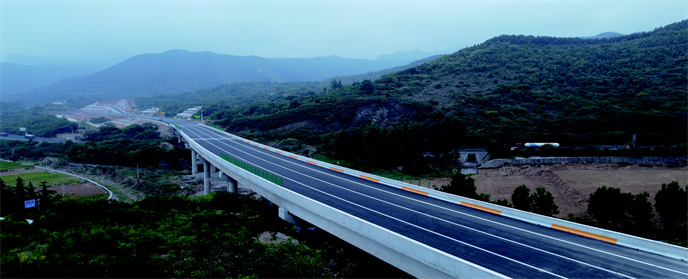 The renovation and expansion project of the G22 section of the Qingdao Lanzhou Expressway from Shexian to the Hebei Shanxi border adopts the "4+3" seven lane expressway standard for construction. The existing four lane expressway will be transformed into a one-way four lane expressway, and a new half will be built with a one-way three lane road. The total length of the route is 13.792 kilometers, with a total investment of 1.651 billion yuan. The Qinglan Expressway is a major horizontal transportation channel connecting the provinces of Shanxi, Hebei, and Shandong. It is an important resource transportation channel and an important economic artery connecting coastal and inland areas, as well as connecting multiple resource-based cities along the route. It plays an important role in promoting the adjustment, transformation, and upgrading of the economic structure of cities along the route, and has contributed to the coordinated development of Beijing Tianjin Hebei and the economic development of the Central Plains Economic Zone, achieving significant social and economic benefits. Complete the preliminary land use registration and approval for Qinglan Expressway, permanent basic farmland subdivision and evaluation for the project, demonstration of limited human activities related to ecological protection red lines for the project, preparation and evaluation of land saving evaluation reports for the project, handling of illegal land use and updating of real estate ownership certificates for the project, and registration and approval of permanent land acquisition for the project.
The renovation and expansion project of the G22 section of the Qingdao Lanzhou Expressway from Shexian to the Hebei Shanxi border adopts the "4+3" seven lane expressway standard for construction. The existing four lane expressway will be transformed into a one-way four lane expressway, and a new half will be built with a one-way three lane road. The total length of the route is 13.792 kilometers, with a total investment of 1.651 billion yuan. The Qinglan Expressway is a major horizontal transportation channel connecting the provinces of Shanxi, Hebei, and Shandong. It is an important resource transportation channel and an important economic artery connecting coastal and inland areas, as well as connecting multiple resource-based cities along the route. It plays an important role in promoting the adjustment, transformation, and upgrading of the economic structure of cities along the route, and has contributed to the coordinated development of Beijing Tianjin Hebei and the economic development of the Central Plains Economic Zone, achieving significant social and economic benefits. Complete the preliminary land use registration and approval for Qinglan Expressway, permanent basic farmland subdivision and evaluation for the project, demonstration of limited human activities related to ecological protection red lines for the project, preparation and evaluation of land saving evaluation reports for the project, handling of illegal land use and updating of real estate ownership certificates for the project, and registration and approval of permanent land acquisition for the project.
Other
Qinhuangdao (Beidaihe Airport) to Tangshan (East Outer Ring Road of Tangshan City) Expressway Qinhuangdao Section Project (preliminary land use volume registration and approval, temporary land reclamation plan) Surveying and Demarcation of Building Material Channels in Xiong'an New Area The Beijing Xinjiang to Beijing Tibet Expressway Connection Line Project (Land Pre review, Reclamation Plan, Permanent Basic Farmland Redevelopment, Overburden Mining Inquiry, Ecological Protection Red Line Demonstration, Land Acquisition Volume Filing and Approval) Travel route for Wild Duck Lake Farm (land pre-approval, investigation of overlying mines, preparation of planning and connection schemes, and submission of land acquisition documents for approval) The ecological protection red line involved in G234 National Highway in Shexian County is a limited human activity demonstration
Water industry
Zhangjiakou Water Diversion Project
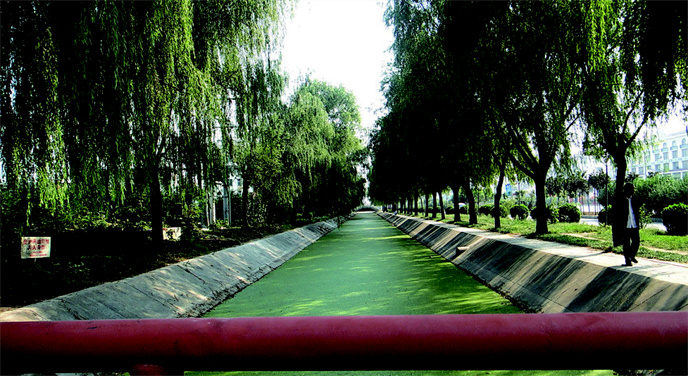 The project is jointly planned and implemented by our city and Yongding River Basin Investment Co., Ltd. It is divided into two parts: the northern line (Yanghe Diversion Project) and the southern line (Shihu Reservoir Construction and Water Transfer Project), mainly including the water diversion hub project, regulating pool and surface water plant project, pipeline water transfer project, wetland purification project, Shihu Reservoir construction, etc. The total investment is 9.861178 million yuan. The project utilizes surface water and external water transfer within the area to ensure the water supply demand in the main urban area of Zhangjiakou, forming a dual water source supply system combining a newly built surface water plant and an existing Yaozhanbao groundwater plant, improving the water supply guarantee rate in the main urban area of Zhangjiakou, solving the domestic and industrial water demand in the main urban area, and improving the ecological environment and water resource carrying capacity of the watershed. Complete the preliminary review of project land use, preparation and evaluation of project survey and demonstration reports, and preparation of planning linkage schemes.
The project is jointly planned and implemented by our city and Yongding River Basin Investment Co., Ltd. It is divided into two parts: the northern line (Yanghe Diversion Project) and the southern line (Shihu Reservoir Construction and Water Transfer Project), mainly including the water diversion hub project, regulating pool and surface water plant project, pipeline water transfer project, wetland purification project, Shihu Reservoir construction, etc. The total investment is 9.861178 million yuan. The project utilizes surface water and external water transfer within the area to ensure the water supply demand in the main urban area of Zhangjiakou, forming a dual water source supply system combining a newly built surface water plant and an existing Yaozhanbao groundwater plant, improving the water supply guarantee rate in the main urban area of Zhangjiakou, solving the domestic and industrial water demand in the main urban area, and improving the ecological environment and water resource carrying capacity of the watershed. Complete the preliminary review of project land use, preparation and evaluation of project survey and demonstration reports, and preparation of planning linkage schemes.
Nanjuma River in Xiong'an New Area
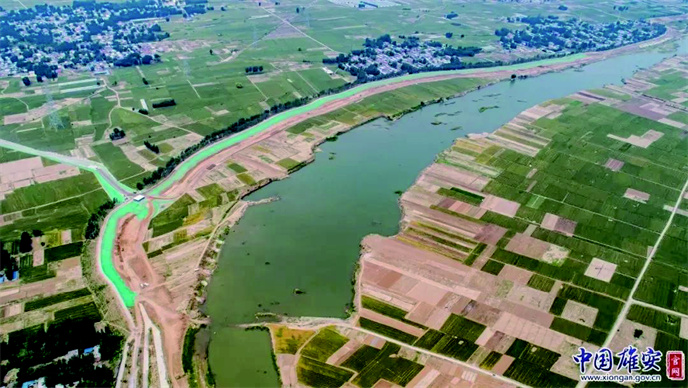 The Nanjuma River Flood Control and Management Project is an important flood defense line in the northern part of the starting area of Xiong'an New Area. The preliminary design approval of the project has a total investment of nearly 2.7 billion yuan. The total length of the South Juma River treatment is 40.3 kilometers, of which the right embankment (Rongcheng section) of the South Juma River is about 19.3 kilometers long, starting from Goushi Village and ending at the Xingaifang Hub diversion gate. The project will raise and reinforce the existing embankment, with a embankment level of Class I and a flood control standard of once every 200 years. Complete the permanent land acquisition for the project and submit it for approval.
The Nanjuma River Flood Control and Management Project is an important flood defense line in the northern part of the starting area of Xiong'an New Area. The preliminary design approval of the project has a total investment of nearly 2.7 billion yuan. The total length of the South Juma River treatment is 40.3 kilometers, of which the right embankment (Rongcheng section) of the South Juma River is about 19.3 kilometers long, starting from Goushi Village and ending at the Xingaifang Hub diversion gate. The project will raise and reinforce the existing embankment, with a embankment level of Class I and a flood control standard of once every 200 years. Complete the permanent land acquisition for the project and submit it for approval.
Baigou River Treatment Project (Zhuozhou Section)
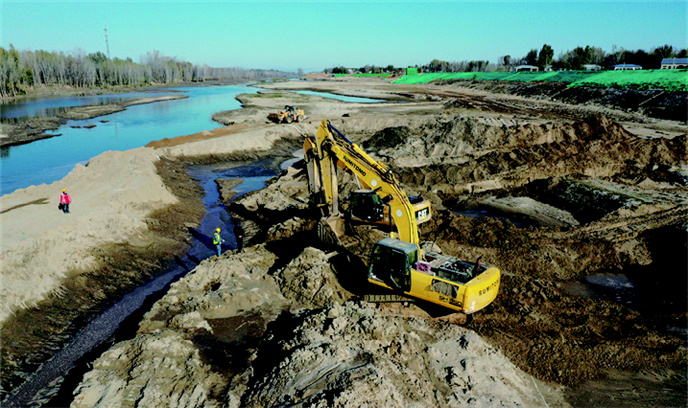 The Baigou River is the lower section of the northern branch of the Daqing River, a tributary of the Haihe River. The upper section is the Juma River, and the middle section is the North Juma River. Originating from Laiyuan County, passing through Laishui, Fangshan District of Beijing, and reaching Matou Town in the northeast of Zhuozhou City, it is called Baigou River. The Baigou River is the flood defense line of the temporary gang group in Xiong'an New Area and an integral part of the flood control system in the north of the Daqing River. It is of great significance to ensure the flood control safety of Xiong'an New Area and Zhuozhou City, and to ensure the safe discharge of the Yongding River's flood exceeding the standard after entering the north branch of the Daqing River. According to administrative divisions, the project is divided into four sections from upstream to downstream: Zhuozhou, Gu'an, Gaobeidian, and Baigou New City. Each section has been approved for project approval, with a total length of 123.54 kilometers of reinforced embankments and an estimated total investment of 4.369 billion yuan. The flood control standard for the left embankment is once every 100 years, and for the right embankment it is once every 20 years. Complete the preparation and acceptance of project survey results, permanent basic farmland subdivision, temporary land reclamation plan, and social risks of the project Preparation of evaluation report and submission of project permanent land acquisition volume for approval.
The Baigou River is the lower section of the northern branch of the Daqing River, a tributary of the Haihe River. The upper section is the Juma River, and the middle section is the North Juma River. Originating from Laiyuan County, passing through Laishui, Fangshan District of Beijing, and reaching Matou Town in the northeast of Zhuozhou City, it is called Baigou River. The Baigou River is the flood defense line of the temporary gang group in Xiong'an New Area and an integral part of the flood control system in the north of the Daqing River. It is of great significance to ensure the flood control safety of Xiong'an New Area and Zhuozhou City, and to ensure the safe discharge of the Yongding River's flood exceeding the standard after entering the north branch of the Daqing River. According to administrative divisions, the project is divided into four sections from upstream to downstream: Zhuozhou, Gu'an, Gaobeidian, and Baigou New City. Each section has been approved for project approval, with a total length of 123.54 kilometers of reinforced embankments and an estimated total investment of 4.369 billion yuan. The flood control standard for the left embankment is once every 100 years, and for the right embankment it is once every 20 years. Complete the preparation and acceptance of project survey results, permanent basic farmland subdivision, temporary land reclamation plan, and social risks of the project Preparation of evaluation report and submission of project permanent land acquisition volume for approval.
Energy industry
30 MW Photovoltaic Poverty Alleviation Power Station in Dukubu Township, Huai'an County
30 MW Photovoltaic Poverty Alleviation Power Station in Dukubu Township, Huai'an County The 30 MW photovoltaic poverty alleviation power station project in Dukoubao Township, Huai'an, is constructed by Huai'an Meiheng Photovoltaic Power Generation Co., Ltd. The project is located near Danangou Village in Dukoubao Township, covering an area of about 1200 acres. It is a centralized photovoltaic power station in mountainous areas with a total investment of about 245.6872 million yuan. The total installed capacity of the project is 30 megawatts, built using 105240 pieces of 285 watt monocrystalline solar cells. The project construction is aimed at alleviating the energy crisis and environmental pressure in Zhangjiakou. Zhangjiakou power grid is an important component of the Beijing Tianjin Tangshan power grid, not only responsible for supplying power to the local area, but also for delivering power to the capital Beijing. It is an important channel in the entire North China power grid's West East power transmission pattern and occupies a very important position in the Beijing Tianjin Tangshan power grid. After the completion and operation of the photovoltaic power station in this project, it will be able to transmit electricity to Hebei North Grid every year. On the one hand, it will provide a certain power guarantee for the regional economic development, and on the other hand, it will drive the development of related industries in the region, improve the living standards of the local people, and play a positive supporting role in the local economic construction of Zhangjiakou. Complete the preliminary review of project land and adjust project planning.
Other
Preliminary review of land for the 200 MW photovoltaic power station project in Beiqingyangguan, Quyang County Preparation of Preliminary Review and Site Selection Opinion for the Construction Land of Nangong Guodian Investment Baita Wind Power Project Nangong City Guoshun and Guolong Agricultural Photovoltaic Complementary Power Generation Project (Land Pre review, Survey and Delimitation, Temporary Land Reclamation Plan, Planning Adjustment, Permanent Land Acquisition Volume Filing and Approval) Zhuozhou Lianchi Songlindian Natural Gas Pipeline Project (Social Stability Risk Assessment, Temporary Land Reclamation Plan, Permanent Land Acquisition Volume Filing and Approval), etc